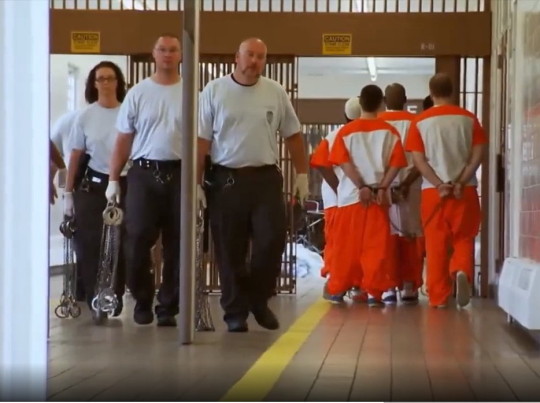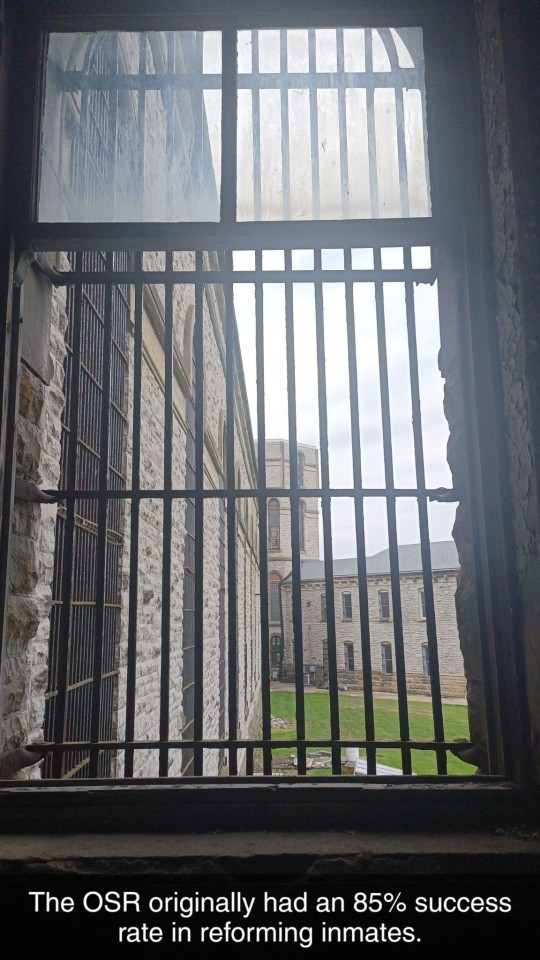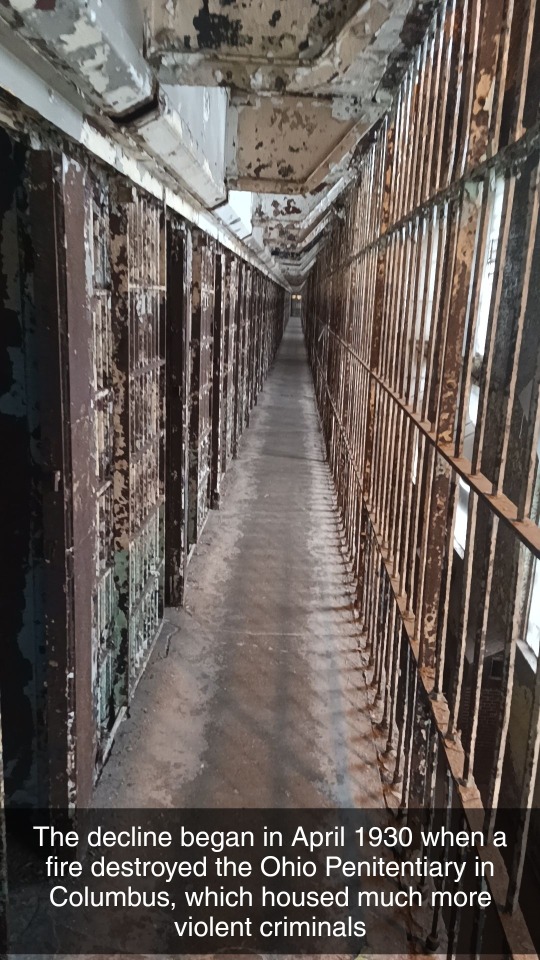#ohio prisons
Explore tagged Tumblr posts
Text
"It is probably understandable that virtually every description of Warden Preston Thomas offered by inmates before and after the fire portrayed him in an adversarial light. The warden does not come across any better in the autobiography of James V. Bennett, who rose to become the director of the Federal Bureau of Prisons between 1937 and 1964. As a lawyer considering his career options in the 1920s, he decided to gain “additional seasoning and insight” by setting out on a tour of some typical state prisons, starting with Columbus. It was here that Bennett had what he described as “probably the decisive experience of my early career.” His “first view of the antiquated institution was frightening and foreboding” as he looked at “the stone prison, with its high walls and bristling towers patrolled by guards.” For a brief moment, he considered walking back out, having lost some of his “desire to present my letter of introduction to the warden [Thomas].”
Bennett was kept waiting through what he considered “an unnecessary delay” before being led into the office of Warden Thomas. The warden
sat at a bulky, square oak desk that had large round, carved legs. The desk seemed as solid as the stones of the prison wall. Thomas checked my credentials, asked to be remembered to a congressman we both knew, and sent for a guide, who, I thought, was to take me around to the workshops. Later I learned he [the guide] was a former treasurer of the state who had put his hand in the till.” Thomas then ordered the guide to “show Mr. Bennett around and bring him right back here.
Upon Bennett’s return from his tour, he was welcomed back to the warden’s office to what he thought would be a productive dialogue about penology. The warden explained that he had “an extremely tough job, and he was not too impressed by ‘softies’ and ‘do-gooders,’” his shorthand for prison reformers. While the warden was a supporter, he said, of prison industrial work, he saw it as a fool’s errand at a time when “there was not enough of a market for prison product in the state agencies.” He reserved some of his rancor for the unions, commenting that “the laborskates” had too much influence. And “as for the prisoners, they were getting what they deserved.”
When Bennett’s time to speak came, he began by asking Thomas how prison officials were able to “maintain discipline and how they punished offenders.” Deciding it was easier to show than tell, the warden told Bennett, “Come with me…. I’ll show you.” The two men proceeded back across the prison square toward a small brick structure. The warden banged on the wooden door. It opened almost immediately and they strode into a “small, dark room with a huge bench at the far end.” He explained that this was his “‘courtroom,’ where he and his deputies sat in judgment upon prisoners who violated the rules.” Punishments could range from losing visiting and correspondence privileges to losing good behavior credits and receiving a stint in “the hole.” It was then time to visit the hole, which was conveniently located in the same building.
The warden ordered a guard to open up the room to show the young “do-gooder” some old-fashioned justice. They entered the room through “a barred, steel door” that had to be unlocked before they proceeded through a “steel boilerplate door.” They then entered “a narrow corridor lined with more steel doors, and Thomas motioned to a guard to open one. There stood a pathetic creature, his eyes staring vacantly, his hands handcuffed to a bar halfway up the wall.” Asked how long he had been there, the prisoner said five days. Apparently, the warden was not expecting this answer. Thomas told him, “I don’t believe you” and rushed Bennett back out through the corridor. One might have thought that Thomas had already revealed too much about his punitive regime, but he insisted on showing Bennett the cells reserved for laggards who refused to work. These men were forced to stand “for hours or for days in tiny scrap-iron cages, in which there was no room to sit down, until they agreed that washing pots and pans or shoveling coal was not such a bad fate.”
Bennett decided it would be foolhardy to ask any more questions or to argue with the warden about what he had just witnessed. He wrote that he “had seen enough, and I never wanted to get out of a place so badly in my life.” He thanked the warden “half-heartedly” for “taking the trouble to show me around and headed for the gate.” He then canceled the rest of his prison inspection itinerary.
....
When .... Bennett visited the Ohio Penitentiary in the mid-1920s, as he crossed the prison’s interior courtyard he came across “a line of men moving across the square in a long, skating stride, each man with one arm on the shoulder of the man in front of him.” He was witnessing the iconic “lockstep” movement, in which inmates “moved rapidly without a sound other than the shuffle of their shoes on the walk, and their eyes [were] focused on the ground.” Bennett had occasion to observe “several groups of gray-clad men marching about silently” on his visit. The images stuck with him; he wrote in his autobiography decades later about “the large numbers inked on the backs of their rough, wrinkled shirts,” concluding, “It was a depressing introduction.” These large inked numbers would play a crucial role in identifying some of the victims of the penitentiary fire.
- Mitchel Roth, Fire in the Big House: America’s Deadliest Prison Disaster. Athens: Ohio University Press, 2019. p. 123-124, 142-143
#ohio penitentiary#columbus ohio#big house#ohio prisons#ohio state penitentiary#prison discipline#prison conditions#maximum security institution#american prison system#history of crime and punishment#academic quote#reading 2024#penal modernism
0 notes
Text
fact checking the "haitian immigrants are eating pets in springfield ohio" thing so you dont have to
(even though you should abaolutely look into it yourself instead of taking the word of some stranger on the internet)
it is not true.
it started because of four separate incidents: a woman made a facebook post that incidentally incited the rumor; there was a graphic video of a woman (in no way connected to haiti) from canton, ohio allegedly killing and eating a cat; a picture of a man from columbus, ohio carrying a dead goose down the street; and the death of an 11 year old boy after his school bus was crashed into by an immigrant from haiti.
first, erika lee was the woman who made a facebook post about her neighbor's missing cat. the neighbors, according to the post, thought that their haitian neighbors had something to do with the disappearance, but no proof to back it up. erika admits deep regret for her accidental spreading of hate towards the haitian immigrant community, and has since deleted the post.
second, the woman who alleged to have killed a cat with intentions to eat it was from canton, ohio, not springfield. she isn't a haitian immigrant, nor does she have any relation to haitian immigrants- she's always lived in canton.
third, the guy carrying the dead goose? the image was found to be taken in columbus ohio and posted on the columbus subreddit. the person who took the photo has admitted regret for posting it because of how its been weaponized against the haitian immigrant community. also we don't know whether or not the guy killed the goose or for what purpose, if so.
an 11 year old boy did die in a collision caused by a haitian immigrant crashing into a school bus. however, the boy's father has stated that he never allowed trump to politicize his son's death against immigrants.
my conclusion? it seems like the far right are trying to cartoonishly demonize the haitian people as a means of inciting fear into voters to get them to support trump. this comes from a place of extreme fascism and racism.
yeah, it's funny to look at what trump said in the debate with harris. "haha he thinks people are eating pet dogs in ohio! crazy, huh?" but let's take a step back to think about where these claims are coming from, and why he's making them. critical thinking, baby
#presidential debate#2024 presidential election#president trump#kamala harris#us politics#politics#immigration#transgender operations on illegal aliens in prison#<- think abt that too#haitian immigrants#springfield ohio#us presidential election#presidential race#2024 elections#yapmode
60 notes
·
View notes
Text
Daniel Villarreal at LGBTQ Nation:
The Supreme Court has agreed to hear a case of an Ohio woman who says she faced workplace discrimination over her heterosexual identity. The case may be the first of its kind. It examines the lengths members of “majority groups” must go to prove that they were discriminated against by “minority” groups. Marlean Ames worked for 20 years at the Ohio Department of Youth Services, a state agency that oversees the confinement and rehabilitation of juvenile felony offenders. In 2014, she was promoted to serve as the administrator of the Prison Rape Elimination Act (PREA), a 2003 federal law that seeks to track and end sexual assaults in all detainment facilities.
In 2017, a gay woman named Ginine Trim became Ames’ new supervisor. In December 2018, Trim gave Ames a performance evaluation that said Ames mostly “met” all of her job expectations and had an “opportunity to improve” in three areas. Then, in April 2019, Ames applied and interviewed to become the Department’s Bureau Chief of Quality — she didn’t get the job.
One month later, the agency’s Human Resources department called Ames into a meeting where they terminated her role as PREA administrator and demoted her to her former role, reducing her pay from $47.22 an hour to $28.40 an hour, court documents allege. The agency’s director and assistant director who oversaw Ames’ demotion are both heterosexual, and at different times, they provided different reasons for her demotion. Once, they mentioned that her position was an “at-will” role whose work could be terminated at any time; another time, they said that they wanted a worker who would regularly exceed (rather than just “meet”) the job’s expectations. The following December, the department hired Alexander Stojsavljevic, a 25-year-old gay man, for the PREA administrator position and chose Yolanda Frierson, a gay woman, as its Bureau Chief of Quality. Ames filed a discrimination charge with the Equal Employment Opportunity Commission (EEOC) and then filed a lawsuit. Both a district court and the 6th U.S. Court of Appeals ruled against Ames.
[...] However, in its summary judgment, the district court said Ames had failed to prove that she was a member of a “protected class” of people who have historically been discriminated against for their personal characteristics. The court also said Ames failed to substantiate “background circumstances” proving that LGBTQ+ people had made the decisions against her or that they had discriminated against other heterosexual workers before in the past.
SCOTUS will hear the Ames v. Ohio Department of Youth Services case this term.
The Ames case highlights Marlean Ames suing over being “discriminated” for being heterosexual (or straight) that led to her demotion from her job.
#Marlean Ames#SCOTUS#LGBTQ+#Homophobia#Prison Rape Elimination Act#Ginine Trim#Alexander Stojsavljevic#Yolanda Frierson#6th Circuit Court#Ames v. Ohio Department of Youth Services
19 notes
·
View notes
Text
Orange and White, but no stripes
Lucasville, Ohio
Google maps: https://maps.app.goo.gl/HZ1LaaNafvajzkQC9



Note the leg irons held by the guards.
From: Hard Time, Prime Video S2 E8 - Worst of the Worst
And: Maximum Security | Hard Time National Geographic https://www.youtube.com/watch?v=97JvUUBG-00
#orange and white#no stripes#maximum security#prisoners#Lucasville#Ohio#Southern Ohio Correctional Facility#Prison#leg irons
32 notes
·
View notes
Text
Illinois is a more likable character than Yancy by a MILE but you guys wont believe me bc Yancy has a musical number <\3
#LISTEN. IK YOU LIKE HIM. BUT HES A MANIPULATOR THATS WHAT HE IS#I suppose its a good thing that ppl like him bc it proves it works like its fun meta-wise#but if you stay with Yancy he is eventually going to kill you that is what the ending meant !!!!#Yancy's “stay” ending ends with him killing a guy to guarantee he'll stay in the prison and its implied this is what hes ALWAYS DONE#like he persuades ppl into staying with his musical number and “Ohio” accent and then disposes of them when needed#YANCY IS NOT IN LOVE WITH YOU HE IS GOING TO KILL YOU#ANYWAY Illinois on top#BTW IDC IF U LIKE YANCY YOU DO YOU BUT PPL HAVE BEEN MISINTERPRETTING HIS CHARACTER SINCE HEIST#I have heard he has an ending in Space but i havent watched space pt2 yet#MARK HIMSELF PREFERS ILLINOIS. SO YEAH#markiplier#this is all /lh#ahwm#a heist with markiplier#in space with markiplier#iswm#illinois ahwm#yancy ahwm
29 notes
·
View notes
Note
You seem to be pretty good at documenting the history of uniforms, as in the Indiana question I asked. What's the more recent (say 1950's onward) history for Ohio? I seem to find that they had jeans on at a relatively recent point (80's or so) but then moved to twill work pants and a chambray-ish top, and lately have gone the Tennessee route with a scrub style top, while ditching the belt loops on the pants and going elastic down there.
Thank you for the great questions! Obviously this is one of my main passions.

Ohio Prisons entered the 1950s through the 1960s with its convicts wearing hickory striped shirts, prison denim pants and denim yard coats, all made by fellow convicts.

The 1970s saw the Ohio Prisons move to all chambray shirts and denim dungaress.

By the last few years, the general trend was to orange scrubs.


Lately, Ohio mugshots show wild variety of t-shirts and a mixed bag of prison clothes!

Quite frankly, Ohio is one of the least photographed and documented prison systems and, it sucks to try to document it!


I will tell you that the movie Shawshank Redempton, filmed largely at Mansfield Ohio, very closely and faithfully replicates the early Ohio prison uniforms!!!
Question about the Ohio Prison Uniform History
14 notes
·
View notes
Text
Trigger warning for pictures of a prison, brief mentions of inhumane conditions, starvation, death and violent crimes.










I got to visit the Mansfield Reformatory in Mansfield, OH over the weekend. This place originally began as a 'midway' point for young men who had committed crimes that were too serious for juvie, but not serious enough for prison.
In 1896, the Reformatory welcomed 150 inmates and was entirely self sufficient. Any repairs needed were done by inmates, food was grown on the property, livestock were raised by inmates. Not only did this keep costs low, but it helped inmates gain skills to work after their release. In its early years, the Reformatory had an 85% success rate, meaning that 85% of inmates were not re-admitted within 5 years of their release.
April 1930 saw one of the deadliest fires in U.S. history, the Ohio Penitentiary Fire in Columbus. It's believed the fire began when a rag was left too close to a candle. Some guards left the prison without unlocking any cells. More than 300 men perished in the fire.
Of those that survived, some were transferred to the Reformatory. Again, the Reformatory wasn't meant to hold inmates with violent crimes and the administration argued against taking in these inmates, protesting that they didn't have the room or the staff and that this could be detrimental to their current reform program, but the Reformatory was forced to house inmates from the Penitentiary.
The Reformatory saw state funding being cut a few decades later. Those put into solitary were given 1 meal once per day and it was often stacked that one meal would be given at 12:01 am on one day, then not again until 11:59 pm the second day, meaning inmates would go 47 hours without food. The Reformatory had such a severe cockroach problem that inmates would sleep with toilet paper stuffed in their ears to prevent anything from crawling in. Guards were so unused to handling violent inmates that they often did not interfere with any fights or step in unless absolutely necessary. The Reformatory became a maximum security prison in the 70s and would remain as such until its closing.
In the 1980's, former inmates sued the Reformatory for its inhumane conditions. The state ruled that the Reformatory was to be closed and another facility, the Mansfield Correctional Institution, was to be built to replace it. The state pulled ALL funding from the Reformatory to put into the MCI, meaning the Reformatory had absolutely no money the last ten years it was open. More than 200 people died in the Reformatory and, unless they were claimed by family, they were buried on the property, where they still remain.
Visit mrps.org to learn more. If you are ever in the Mansfield area, I can not recommend this tour enough. Those who are working to preserve and restore the Reformatory rely entirely on donations and those who pay for tours, so please check them out!
37 notes
·
View notes
Text
traffic is bad today because there’s a man loose on the interstate wielding a hammer. I hope no one is seriously injured because I fear my very specific recurring dreams are starting to leak into reality
#manifesting that no one dies or is seriously injured#reminder to check the news later to see if this is still allowed to be funny#can’t have shit in ohio#the recurring dreams aren’t a joke#most recently it’s been ‘mark david chapman has escaped prison and only YOU can stop him’#usually through some sort of ridiculously exaggerated violence
5 notes
·
View notes
Text


Kiss me here. 🥀
#abandoned places#old prison#ghost hunting#date night#spooky aesthetic#my pics#my post#decay#haunted#goth aesthetic#goth dates#ohio state reformatory#dark academia#grunge aesthetic#alt#aesthetic#kiss me#architecture#dark#creepy aesthetic
4 notes
·
View notes
Text

x
5 notes
·
View notes
Text
I have so many fun facts about myself that aren’t really fun. They’re just like… mediocre. So I’d never bring them up when someone asks me for a fun fact, and they are too short to really be entertaining stories, so I just have a books worth of little events in my life that are only somewhat intriguing but they compose who I am. And I think everyone is like that to a degree. We’re all little stories that we don’t think are worth telling. Not because we don’t want to, but because we don’t think don’t think they’re worthy of being heard.
#no clue what to tag this#random thoughts with rowan#existentialism#random thoughts#so anyway have a few of these little tid bits about me#a stranger#as a child I cursed when I cut the tip of my finger off and my first priority was apologizing for cursing#I once pretended to be interested in the Navy and made an appointment with a recruitment officer just so I could take his mug ☕️#I’ve had to pull tarantula fangs out of one of my coworkers#I once told a teacher that they couldn’t call my mom on me because she was in prison#I learned how to juggle because I thought it was imprsssive and then stopped practicing once I leaned that people thought it was lame#I had a bird named Devil who I only owned for two days before returning to the pet store after he attacked my mom#I set a bag of popcorn on fire by accident and the first thing I did was grab it with my hands#during my freshman year of high school I collected chapstick because I thought my future girlfriend would want to have options…#cont. and I never once wore any of the 60+ chapsticks of mine while kissing someone#instead of selling lemonade I used to sell painted rocks on a street corner#during a group project I forgot how to pronounce Ohio#In elementary school I told the lunch ladies I was allergic to wheat because I hated whole wheat and now I actually am#I know most of the lyrics to the songs from The Greatest Showman but have never seen it#as a child I thought plums were a made up fruit#I planned on joining the military out of spite against people telling me I would not have enjoyed it#I flooded a classroom and got doused by a chem shower on my second day as a lab assistant#and uhhh there’s more but have this for now#fun facts
8 notes
·
View notes
Text
"In the early 1920s, the future head of the Federal Bureau of Prisons, James V. Bennett, visited the Ohio Penitentiary on a fact-finding tour. His escort led him around to various shops that were “poorly lit, filled with obsolete and worn out equipment.” In most of the shops, many of the prisoners were just “squatting against walls of rooms or loitering by the drinking fountains.” The laggard inmates did not seem bothered by the proximity to their keepers in charge of the workshops, who sat in chairs on platforms just three feet above the floor, “with heavy clubs in their hands. Every now and then, a guard would pound his club on the platform and point at a prisoner, or shout an order, and the prisoners would understand. I thought the prisoners looked dispirited and hopeless, but the guards could not be blamed.” Almost half a century later, Bennett would recount in his autobiography that “the enormous cellblocks depressed me beyond despair.” One of the cellblocks housed “more than 900 men, with two prisoners in every ten-by-five-foot stone walled cubicle.” His inmate guide noted, “He lived on the top floor and it got ‘damned hot in summer.’” As they continued down a corridor, Bennett hesitated when he came upon “several men in their cells pacing up and down with unusual intensity, jabbering to themselves, rattling their bars, or shouting obscenities.” His escort told him not to pay any mind: “they were psychos,” kept among the general population “because there was no other place for them.”
...
When it came to the biggest of the big houses, idleness at the Ohio Penitentiary “was much more conspicuous [here] than in many prisons.” The Columbus penitentiary was home to an “idle room,” on the third floor of a manufacturing building, where “hundreds of men spend their days sitting on benches in absolute idleness, under the eyes of guards.” One contemporary account described the building as “almost ready to collapse.” Few of the convicts were constantly employed. Between fifteen hundred and two thousand inmates were idle at any given time, confined to the large raftered, barn-like room furnished with benches and tables. Here, convicts languished from morning until nighttime lockup. It was not uncommon for cocaine and morphine addicts to be housed in the idle house as well. One inmate noted, “You can spot them in the Idle House, sitting silent, staring into space with lack-luster eyes, their entire bodies twitching from time to time in that peculiar agony that comes upon the dope fiend when he hasn’t any drugs.”
According to one survey, idleness was “much more conspicuous here than in many prisons by the use of the ‘Idle room,’ in which hundreds of men spend their days sitting on benches in absolute idleness under the eyes of the guards.” Some would argue that the Idle House was still a more humane alternative than sitting locked up all day in cells or in dark, crowded dorms."
- Mitchel Roth, Fire in the Big House: America’s Deadliest Prison Disaster. Athens: Ohio University Press, 2019. p. 93, 96.
#ohio penitentiary#columbus ohio#big house#ohio prisons#ohio state penitentiary#convict labour#prison work#prison conditions#minimum security institution#american prison system#history of crime and punishment#academic quote#reading 2024#unemployment in prison#penal modernism
0 notes
Text









Ohio State Reformatory, Ohio | February 2023
7 notes
·
View notes
Text

OZ but if they were in some sort of horror movie. Guil’s the redneck guy (because I thought it was funny), Ange is the killer (he’s had enough of everyone), Robin is the slightly deranged but sane protagonist (he’s convinced that the chicken is a cat), and Eve is the person who knows what’s up (he comes to save Robin.)
#visual prison#visupri#guiltia brion#robin laffite#ange yuki#eve louise#was too lazy to finish this#guil drives a pickup truck#Ange is in the meat business#only in ohio#French Redneck
7 notes
·
View notes
Text
Putting up "NEGA-OHIO 35 Miles" signs in Ohio to remind the locals not to become callous of their sins. The land hasn't forgotten, and the debt has yet to be repaid.
putting up “HELL IS FAKE” billboards in ohio to start a dialogue
#ohio#Ohioans are guilty of crimes outsiders could only begin to imagine#Ohio is our prison#Ohio shall be our grave#There is no escape
117K notes
·
View notes
Text
#conspiracy theories#bigotry#haitian immigrants#springfield#springfield ohio#they're eating the cats#they're eating the dogs#refugees#islamophobia#sharia law#arab#middle east#women#childless cat ladies#sexism#misogyny#israel#hezbollah#hezballah#hezbolla#pager attack#hamas#antisemitism#transgender operations on illegal aliens in prison#transgender#transphobia#lgbtqia#lgbt rights#trans rights
1 note
·
View note